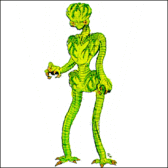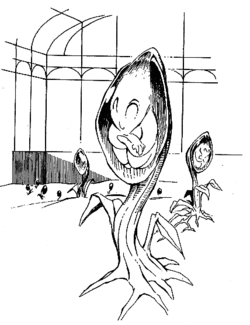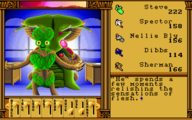Martians
| Martians | |
|---|---|
 Martian from Martian Dreams manual | |
| Only appearance: | Martian Dreams |
The stories of little green men from Mars are true... to an extent. While the Martians are surely green, they are by far not little. And they also have little to do with the other pictures in popular fiction. Martians are actually plant people!
Description[edit]
Martians can be male or female, and their life cycle resembles closely that of plants, with the big difference that they do not root into the ground. They have a complicated social structure and a highly developed civilisation. However, they do not exist in their true form any more. When the evil Raxachk poisoned all of Mars with a deadly plague, their plant bodies all died. Also later attempts by Prektesh to create plant bodies that are immune, failed, since the plague had seeped into the soil.
Today all Martians live in robot bodies disguised as humans on Earth.
Lore[edit]
| “ | The irrefutable evidence of sentient life on Mars leads inevitably to questions about who and what the Martians were. What was their lifestyle? How advanced was their civilization and how was it structured? After the members of the 1893 expedition determined that they could, in fact, survive on Mars, George Washington Carver began seeking answers to these questions.
All available evidence led Carver to conclude that the one-time masters of Mars were sentient plant-creatures -- highly evolved plantimals, if you will. The remains of cities and towns -- called "groves" -- and the remarkable artifacts found in these settlements indicate a high level of civilization. Life Cycle Like all Martian plantimals and, for that matter, all Earthly plants, the sentient Martians (to be called simply "Martians" from here on) were born when seeds were planted in the ground, watered. nourished by sunlight and minerals, and protected from worms and carnivorous plantimals. However, Carver's study of records left by the Martians indicate that they grew to maturity somewhat differently than their non-sentient cousins. First, each Martian plant grew just a single pod, and these pods didn't split open naturally when the creature within reached maturity. In fact, if left on the plant, Martian pods would become overripe, killing the young one within. For that reason, the Martians tended their pods carefully and, using a knife-like implement specifically designed for the job, split the pod open at just the right time, releasing the "young" male or female Martian. The new organism was fully aware, but not fully mature. Were it not for the protection and guidance provided within the walls of the Martian groves, the young could not have survived. The Martian life cycle began with an elaborate sexual ritual involving a male, a female, and a species of now extinct flying worm Carver called a "pollinator." The parties involved would gather in a sunny greenhouse in the couple's home grove. The two Martians would kneel across from each other as pollinators fluttered about them. The worms would land on the male, picking up a dusting of pollen, and then land on a ruff of flower-like structures about the female's neck and shoulders. The pollinated flowers eventually grew into seeds which ringed the female, like strings of pearls. When the seeds had grown, they were gathered and given to the Cultivator, who planted and tended them in a communal plot. Eventually. the seeds grew into seedlings and then into fully grown plants. The plants grew pods and the cycle was complete. The existence of communal plots was probably the most telling difference between the Martians and their non-sentient cousins -- they tended to settle in a few places and buried generation after generation of their dead in a few precisely defined locations. Seeds planted in these locations acquired knowledge and characteristics not only from the previous generation. but from all generations stretching back many thousands of years. The germ of true intelligence was clearly present in the Martians from the very beginning -- they, alone among plantimals, realized the potential benefits of settling in a single location. Still, given what we know of life on Mars, the resulting concentration of racial memory in a single location surely contributed to their dominance of the planet. Martian Life & Social Structure While Carver studied the Martian life cycle, anthropologist David Yellin began a systematic study of the Martian lifestyle as recorded in scrolls and reflected in surviving Martian groves and artifacts. According to Yellin, the secret of Martian success was rootedness. Once a Martian family (or group of families) settled in an area, it remained there, to the benefit of each succeeding generation. Thus, each grove is found today on the same spot it occupied at the dawn of Martian civilization. Martian groves consisted of several homes arrayed around a central grave/nursery plot, the whole protected against nomadic plantimals by a stout wall. The homes were, not surprisingly, made entirely of glass or crystal. In other words, the Martians lived in greenhouses, not unlike the marvelous crystal palaces beloved by the Victorians. The rule among Martians seems to have been "one-home, one-Martian." Since all seeds were planted in a communal birthing plot, there were no families in a sense, all Martians living in a grove were one family. When a Martian died its body was carried to the birthing plot and buried there. As the body decomposed, all of its accumulated memories and experiences were, through some unknown mechanism, transferred into the soil, to be soaked up by seedlings planted there. Thus the seedlings acquired the knowledge of all previous generations in that location. Each Martian birthing plot was tended by the community's Cultivator. This Martian held the fate of his community in his three-fingered hands. If the plot were damaged, the development of subsequent generations could be set back severely. If the damage were so great that the community had to move and find a new plot, a small amount of dirt would be collected from the plot and carried to a new location. Martian records indicate that this only rarely resulted in success. Needless to say, the Cultivator was held in the highest respect. Assisting the Cultivator was the Gatherer. The Martian who held this position gathered all of the leaf droppings and other plant matter and kept up the community's compost heap. The Gatherer was also responsible for bringing the dead to the birthing plot, where their knowledge could be imparted to succeeding generations. Another Martian, the Arborist, healed the sick and wounded. This involved taking cuttings, healing diseases, grafting limbs, and so on. Coordinating the activities of these key Martians and seeing to the everyday needs of the citizens of each grove was the Agrarian. Think of the Agrarian as akin to a human Mayor and you won't be too far off the mark. In addition to internal affairs, this Martian negotiated water rights with other groves and took responsibility for inter-grove soil trading. Such trading ensured the widespread dissemination of knowledge and enriched the overall Martian stock. The Agrarian also made sure the underground power plants and factories were well-maintained, ensuring the continued idyllic existence of Martians on the surface. Martian records indicate that there were once scores of groves. Today, only four are intact enough to reveal anything of Martian life (to say nothing of sheltering the members of the 1893 expedition). Olympus, Argyre, Hellas, and Elysium are in surprisingly good repair. Other scattered buildings only hint at the former greatness of Martian civilization. |
|---|

